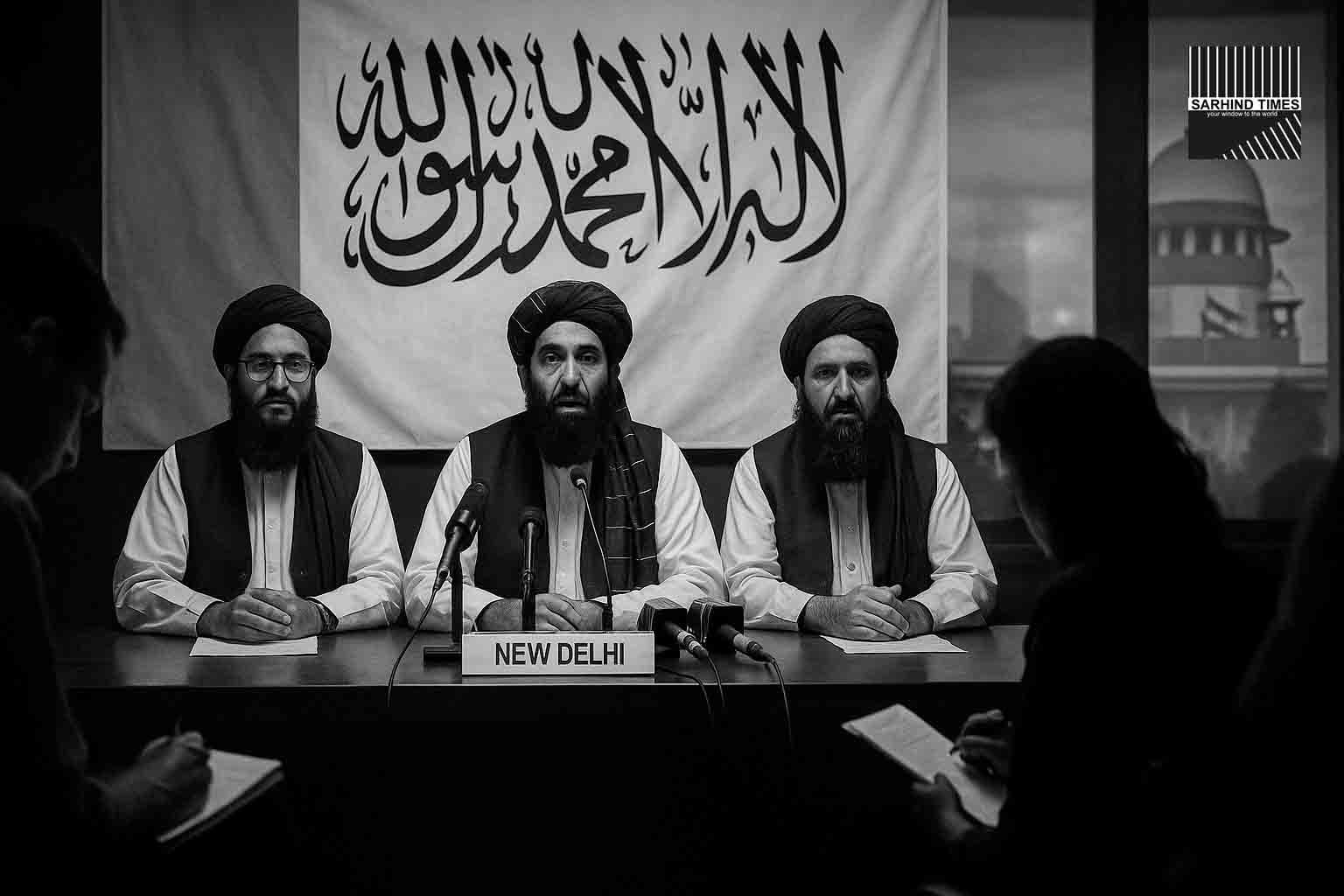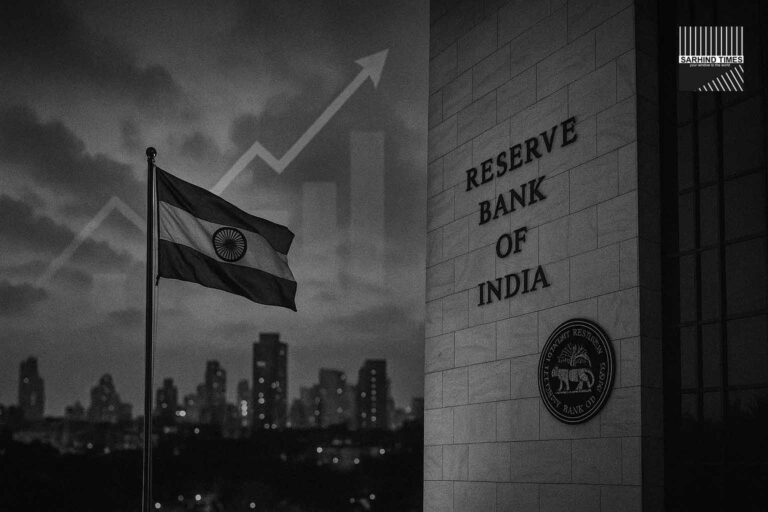In a visible assertion of legitimacy, Taliban representatives displayed their flag as a backdrop at an embassy press briefing in New Delhi — signalling a calibrated, confident shift in tone as India weighs its next diplomatic moves.
At a 44-minute media interaction in New Delhi, Taliban officials unveiled a full flag backdrop for the first time, marking a distinct departure from the discreet tabletop emblem used earlier. The optics highlight the group’s evolving diplomatic posture amid cautious Indian engagement. The development comes as reports suggest India may consider re-opening its Kabul mission in a limited capacity. Meanwhile, former embassy staffers express fear of reprisals, underscoring the human and diplomatic sensitivities of the unfolding situation.
📍 New Delhi, October 13 — Subtle Symbolism, Strategic Signals
At a modest press conference in New Delhi on Friday, a subtle visual shift spoke volumes. Behind the Taliban representatives addressing journalists stood not a small tabletop banner, but a full-size flag of the Islamic Emirate of Afghanistan — white cloth emblazoned with black calligraphy — filling the backdrop of the room.
The 44-minute media interaction, conducted by Taliban-appointed diplomats now occupying sections of the Afghan Embassy in New Delhi, may have seemed procedural on the surface. Yet, the symbolism was unmistakable: an attempt to project authority, permanence, and legitimacy in India’s capital — one of the few major global cities where official diplomatic recognition remains withheld but engagement endures.
🎙️ A Change in Optics: From Quiet Presence to Open Assertion
Until now, the Taliban’s presence in India had been muted. After the group seized power in August 2021, India shuttered its Kabul embassy and halted most official contact, maintaining only humanitarian channels through multilateral mechanisms. The Afghan Embassy in Delhi continued operating under officials appointed by the former Republic — a diplomatic anomaly that persisted for over two years.
That changed gradually. In recent months, Taliban-appointed envoys began informally managing parts of the mission, citing administrative necessity. Friday’s presser marked the first public event in which Taliban representatives addressed Indian media directly, framed by their own symbols rather than the insignia of the ousted government.
“We are here to serve our citizens in India and to represent Afghanistan’s interests,”
— said Qadir Ahmad, a representative aligned with the Taliban’s Ministry of Foreign Affairs.
The presence of the flag, he insisted, was “merely official protocol,” not provocation. But for seasoned diplomats in attendance, the move felt like a carefully scripted test of India’s tolerance.
🇮🇳 India’s Diplomatic Tightrope: Between Recognition and Reality
For India, the press conference is a reminder of an uncomfortable truth — engagement with Afghanistan can no longer ignore the Taliban’s de facto control, even if formal recognition remains off the table.
New Delhi’s position has evolved from outright non-engagement in 2021 to “technical-level contact” today. Indian officials quietly reopened the Indian Technical Mission in Kabul in 2022, staffed by security-cleared personnel to oversee humanitarian aid and development projects.
Reports earlier this month indicated that India was “considering limited reactivation” of its Kabul embassy for consular functions — a move likely to be pragmatic rather than political. The Taliban’s flag in Delhi, however, may complicate this calculus by forcing visible acknowledgement of their authority.
“India cannot ignore who controls Afghanistan. The challenge is doing so without legitimizing the Taliban’s human rights record,”
— said Ambassador T.C.A. Raghavan, former Indian High Commissioner to Pakistan.
🕊️ The Messaging: Assertion Wrapped in Moderation
The Taliban’s Delhi outreach was not overtly confrontational. The spokespersons avoided controversial topics such as women’s education or international sanctions. Instead, they focused on trade, connectivity, and diaspora issues — an agenda carefully tailored to India’s policy vocabulary.
Key talking points included:
- Regional connectivity through Chabahar and Central Asia.
- Security assurances that Afghan soil would not be used against India.
- Calls for humanitarian aid and the resumption of student visas.
In other words, a calibrated diplomacy — one that blends symbolic assertion (the flag) with pragmatic language aimed at gradual normalization.
“The flag was for identity, not aggression,” one Taliban delegate told journalists privately. “We know India respects sovereignty. We respect India.”
⚙️ India’s Strategic Imperatives: Security, Trade, and Stability
India’s engagement with Afghanistan has always been multidimensional — a mix of security interest, economic investment, and historical goodwill.
Before 2021, India had committed over $3 billion in infrastructure projects in Afghanistan — including the Salma Dam, Parliament Building, and road links connecting Zaranj to Delaram. The return of Taliban rule placed those investments in uncertainty.
At the same time, India’s security agencies remain alert to terror networks operating from Afghan soil, particularly the Haqqani network and elements sympathetic to Pakistan-based groups. New Delhi’s approach, therefore, has been to “stay engaged, stay alert.”
The Taliban’s media event — with its strong visuals — is likely to be seen in South Block as both a signal of outreach and a test of boundaries.
🌍 Regional Dynamics: The Shadow of Recognition
While no major power has officially recognized the Taliban regime, most have resumed functional contacts.
- China became the first country to formally accept a Taliban ambassador in 2023.
- Russia, Iran, and Pakistan host regular Taliban delegations.
- Qatar continues to serve as the diplomatic bridge for global dialogue.
India remains cautious but not isolated. Its attendance at multilateral formats such as the Moscow Format and Heart of Asia conferences reflects pragmatic engagement. The recent Delhi press event, however, exposes the next frontier: how long can India maintain unofficial contact while Taliban symbols appear on Indian soil?
“It’s a diplomatic paradox. India wants to talk to Afghanistan, but not to the Taliban — even though they’re one and the same now,”
— commented C. Raja Mohan, foreign affairs analyst.
🧭 The Human Angle: Embassy Staff Caught Between Two Eras
Behind the geopolitical chessboard lie the human consequences of diplomatic transitions.
Several staffers who had served under the former Afghan Republic still occupy rooms in the embassy building in Chanakyapuri, Delhi’s diplomatic enclave. Many of them hold expired visas and face uncertain legal status.
They have voiced concerns about intimidation and exclusion by the Taliban appointees who now control official access.
“We fear for our families back home. Many of us cannot return, and now even our work here feels unsafe,”
— said one employee, requesting anonymity.
Indian officials have refrained from intervening directly, maintaining that the mission’s internal management is “an Afghan matter.” Yet, the embassy split mirrors Afghanistan itself — a divided polity, coexisting under uneasy truce.
💬 The Symbolic Battlefield: Flags and Legitimacy
Flags have always carried deep political meaning. For the Taliban, the white banner with Shahada (Islamic creed) represents both governance and theology.
By replacing the neutral setting with their own flag backdrop, the group is attempting to normalize its image in international settings — transforming from insurgency to statehood.
The Delhi press room, filled with Indian journalists and cameras, offered a stage for precisely that evolution.
“Symbols precede recognition,” said Dr. Shalini Chawla, defense analyst at CAPS.
“Once you accept a flag in a diplomatic context, you accept the government behind it — at least visually.”
For India, this presents a delicate dilemma: whether to treat such optics as procedural, or as creeping normalization that could later be cited by others as tacit recognition.
📜 A Brief History of India–Taliban Engagement
| Year | Development |
| 1996–2001 | India shuts embassy after Taliban’s first takeover. |
| 2001–2021 | India reopens Kabul mission, invests in reconstruction, builds strategic goodwill. |
| August 2021 | Taliban regains control; India evacuates staff and halts official ties. |
| June 2022 | Indian Technical Mission reopened in Kabul for humanitarian coordination. |
| 2023–2025 | Incremental contact through backchannels and regional forums; Taliban manages consular affairs in Delhi. |
This pattern of “cautious re-engagement” mirrors India’s broader West Asia diplomacy — flexible, pragmatic, and guided by national interest rather than ideology.
⚖️ Global Response: The Legitimacy Debate
The international community remains split on how to handle the Taliban’s diplomatic overtures.
While Western nations insist on human rights benchmarks, particularly concerning women’s education and minority protections, regional powers emphasize stability over values.
India’s challenge is unique — balancing security concerns emanating from the Af-Pak corridor with its moral commitment to pluralism and democracy.
For now, the MEA maintains that “India’s policy is people-centric, not regime-centric.”
Yet, events like Friday’s presser blur that distinction. The Taliban’s imagery on Indian soil is likely to provoke debate in Parliament and the media about where India draws the line.
📈 Trade and Transit: Practical Engagement Continues
Despite political caution, economic interaction between India and Afghanistan has quietly resumed.
Trade via Chabahar Port and Wagah border remains active under humanitarian exemptions.
Afghan dry fruits, saffron, and gemstones continue to enter Indian markets, while Indian wheat and pharmaceuticals reach Kabul through Iran’s transit corridors.
The Taliban delegation in Delhi reaffirmed its intention to expand bilateral trade, proposing joint business chambers and easing of visa processes for Afghan traders.
For India, engagement on trade provides a non-political bridge — humanitarian in nature, yet strategically significant.
📢 Reactions Within India
The appearance of the Taliban flag in Delhi has sparked strong reactions from political and civil society circles.
Opposition parties demanded clarification from the Ministry of External Affairs, asking whether the presser had official sanction.
“The government must clarify if this amounts to recognition of the Taliban regime,”
— said Congress MP Shashi Tharoor, adding that such visuals could have “serious diplomatic implications.”
Foreign policy analysts, however, defended India’s restraint, noting that diplomatic spaces often accommodate “de facto realities” without endorsing them.
“Diplomacy is not endorsement; it’s engagement,”
— argued Manoj Joshi, senior fellow, Observer Research Foundation.
🧭 Looking Ahead: Calibrating the Engagement
Officials in South Block remain tight-lipped about next steps.
Sources suggest that India will “observe but not react publicly”, preferring quiet diplomacy over confrontation.
However, behind the scenes, discussions are reportedly underway to establish clear communication protocols for future events involving Taliban-linked representatives.
Analysts believe the next six months will be crucial.
If the Taliban demonstrates willingness to curb terror activity, improve governance, and maintain regional stability, India may expand technical engagement — though full recognition remains off the table for now.
🔚 Conclusion: A Flag, A Signal, A Question
Friday’s press conference at the Afghan Embassy was more than a routine diplomatic event; it was a symbolic inflection point.
By raising its flag in Delhi, the Taliban declared — subtly but unmistakably — its intent to be seen not as insurgents, but as administrators, diplomats, and legitimate representatives of a nation seeking global acceptance.
For India, it reopens an old question in a new context: how does a democracy engage with a regime it does not endorse but cannot ignore?
The answer, as always, may lie in India’s greatest diplomatic strength — strategic patience.
#Afghanistan #Taliban #India #Diplomacy #Kabul #RegionalSecurity #ForeignPolicy #SarhindTimes























+ There are no comments
Add yours